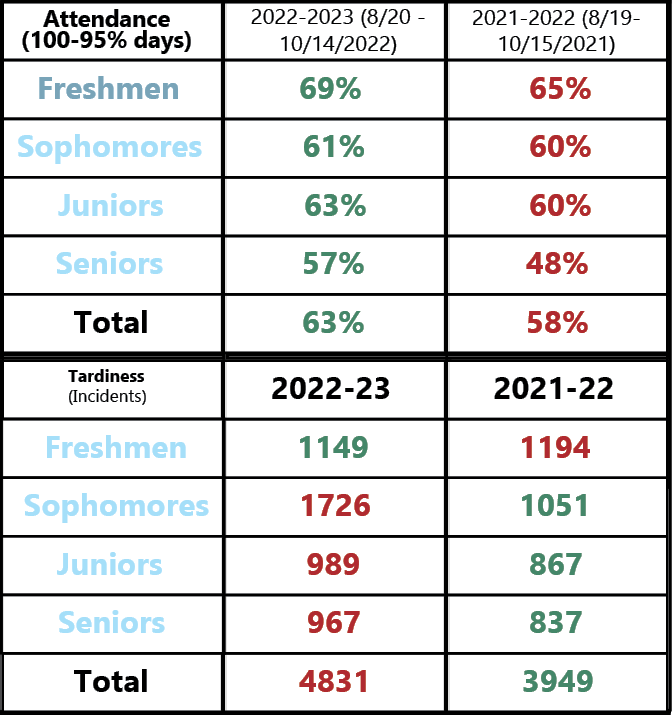Attendance issue arise among students
Administration attempts to improve attendance
December 12, 2022
Following a 14.7% increase in chronic absenteeism since 2019, the administration has placed an increased emphasis on decreasing student absences.
“Going into the [2021-2022] school year, the pandemic required a ton of compassion and flexibility with student situations,” Superintendent Brian Waterman said. “Whether that was remote learning or attendance, tardiness expectations, [and] grading expectations [needed flexibility]. I think as we went into this year knowing that we were getting further and further away from the pandemic, it was really important to reset expectations from student behavior.”
Chronic absenteeism is defined as “miss[ing] 10% or more of school days per year either with or without a valid excuse,” according to the Illinois Report Card. The same website reports that 13.4% of LT students had chronic absenteeism during the 2019-2020 school year; at the time, the state percentage was 17.5%. The school percentage for 2021-2022 is 28.1%, with the state percentage being 29.8%.
“With the initiatives we’ve done, we’re now down to 14% [who are chronically absent], so we’ve nearly cut that in half, so that’s a start,” Director of Curriculum and Instruction Scott Eggerding said.
Eggerding understands the gradual shift that was required after the pandemic to justify a focus on attendance.
“A lot of kids stayed home and liked being home and we were very accommodating; we provided extra support, Zoom, and other things when we were hybrid and then once we came back we weren’t very strict about following up,” Eggerding said. “Because everyone went through that in different ways, and [for] some people it was a very traumatic experience and so we wanted to make sure that they were comfortable. That being said, the sheer numbers of students who weren’t coming [was troublesome].”
Eggerding also described the pressure that student absences could have on teacher’s classrooms and general instruction.
“Teachers were talking about how it was very common to have three to five students absent every single day,” Eggerding said. “Which is very hard to teach an entire group [and] to get caught up on makeup work. Teachers were more frustrated than anybody, basically saying ‘Look, I don’t know who’s going to be in my class from day to day.’”
Students will not show up if they don’t feel welcome and attendance isn’t treated with a serious attitude, Eggerding said.
“More than anything, [attendance] has to be an expectation,” Eggerding said. “Kids don’t come to school when they feel anxiety, when they feel they’re not seen, when they are dealing with social-emotional issues. The more that we can provide the support here, and students know that when they come here they can get the help they need, they won’t feel like they’re better off staying at home.”
This trend has caused the administration to narrow their focus on bettering attendance. This updated policy includes revisions to the student handbook language, systems for interventions and communications, attendance incentive, an increase in counselors, social workers, and training with teachers. There are also three tiers of absent/tardiness classifications for all students ranging in how severe or not severe their attendance, Eggerding said.
“Developmentally, for teenagers, it’s important to be in school,” Director of Student Services Drew Eder said. “Your friends are here [and] your connections to adults who are positive influences are here.”
According to the student handbook on the LT webpage, an individual student is allowed “[seven] parent/guardian-initiated absences/tardies from a class per semester.” Also, five mental health days are allowed which count towards the previous total of seven excused absences. A student’s ability to do well in school is correlated with their attendance, Eder said.
“For those who don’t come to school consistently, it signifies that there might be something else wrong in [their] life impacting them,” Eder said. “That might be mental health, that might be family situations, or a myriad of other circumstances that as a school we feel responsible to support students through. Every student and family has their own unique circumstances, but our goal is to have as many students present in their classes each day. Research shows us the more students are in school, the healthier they are, the more activities they are involved in, and the more likely they are to graduate.”
Upon the first unexcused absence, a student will meet with the Assistant Principal—parents/guardians will be contacted. The second unexcused absence requires parent/guardian contact and a detention for the student. “Third or greater Unexcused Absence[s]” include parent/guardian contact and a Saturday detention for the student according to the handbook.





















![Movie poster for '[Rec]" (2007).](https://www.lionnewspaper.com/wp-content/uploads/2023/04/rec-640x900.jpg)



